Physical Address
304 North Cardinal St.
Dorchester Center, MA 02124
Physical Address
304 North Cardinal St.
Dorchester Center, MA 02124
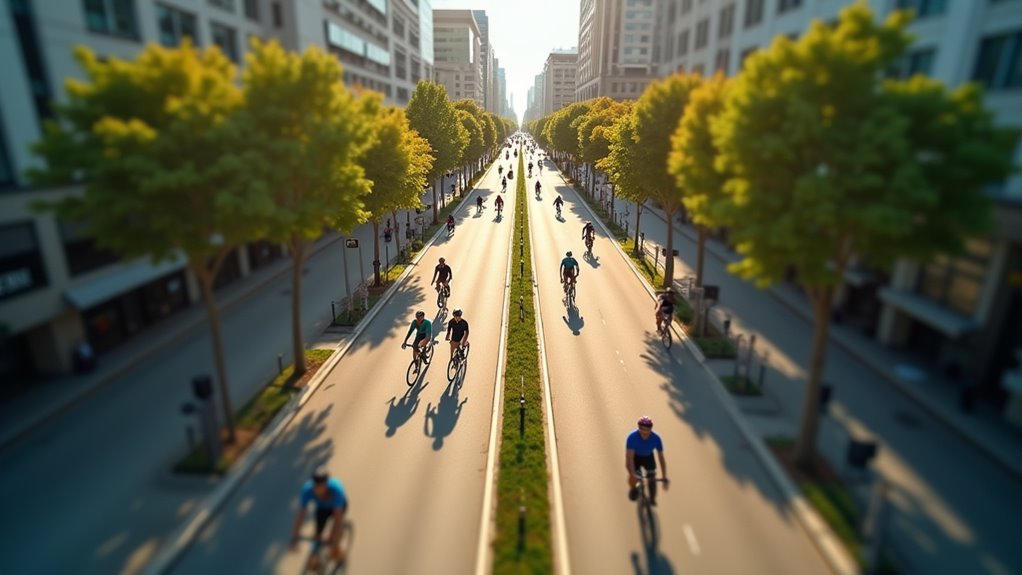
Here are the world's 15 most bike-friendly cities where cycling isn't just transportation—it's a way of life that's transforming urban landscapes.
You probably don’t realize that Copenhagen’s bike lanes generate more rush-hour traffic than their car lanes, with cyclists outnumbering drivers three to one during peak hours. This isn’t just an environmental trend—it’s a complete cultural shift that’s reshaping how entire cities function. From Amsterdam’s floating bike parking garages to Tokyo’s underground cycling networks, these fifteen cities have cracked the code on something most urban planners still struggle with: making bikes the preferred choice over cars.
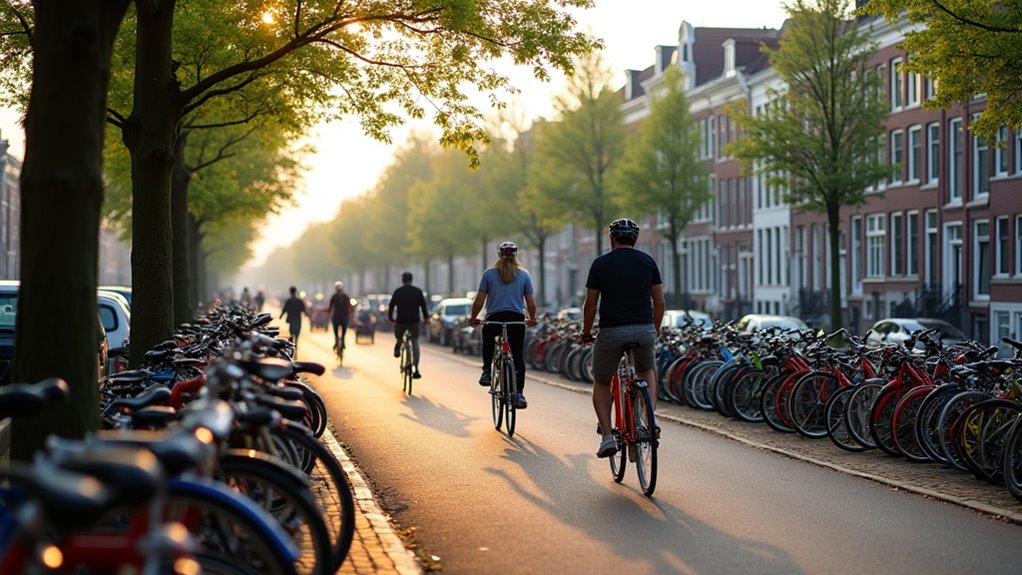
Why does Amsterdam consistently rank as the world’s most bike-friendly city? You’ll discover it’s deeply woven into Dutch culture – cycling isn’t just transportation, it’s a way of life.
When you visit, you’ll notice bikes outnumber cars three to one, with over 400 kilometers of dedicated bike lanes crisscrossing the city.
You can’t miss the practical infrastructure: traffic lights prioritize cyclists, bike parking facilities accommodate thousands of bikes, and flat terrain makes pedaling effortless.
Don’t worry about rain – locals cycle year-round with proper gear and covered bike paths.
You’ll find bike rental shops everywhere, typically costing €10-15 daily.
Pro tip: Dutch cyclists follow unspoken rules, so observe traffic patterns before joining.
Amsterdam’s cycling culture reflects broader values of sustainability, health, and community connection.
For camping enthusiasts who also enjoy adventure sports, Amsterdam’s proximity to natural climbing areas makes it an ideal base for combining urban cycling with rock climbing excursions.
While Amsterdam claims the cycling crown, Copenhagen runs a close second with its revolutionary approach to urban bike infrastructure. You’ll discover the world’s most sophisticated cycling network here, featuring elevated bike lanes, dedicated traffic lights, and snow-clearing systems that keep routes open year-round.
Copenhagen’s revolutionary bike infrastructure features elevated lanes, dedicated traffic lights, and year-round snow-clearing systems that outshine most global cycling capitals.
Copenhagen’s cycling culture runs deeper than infrastructure—it’s woven into daily life. You’ll see parents dropping kids at school via cargo bikes, business executives commuting in suits, and elderly residents running errands on two wheels. The city’s flat terrain and compact design make cycling practical for everyone.
Don’t miss the harbor cycling routes or the innovative Cykelslangen (Cycle Snake), an elevated orange bike path offering stunning waterfront views.
With 40% of residents commuting by bike daily, you’ll quickly understand why Copenhagen sets the global standard for bike-friendly cities. For those inspired to explore Europe beyond city cycling, consider adding backpacking adventures to complement your two-wheeled urban exploration.
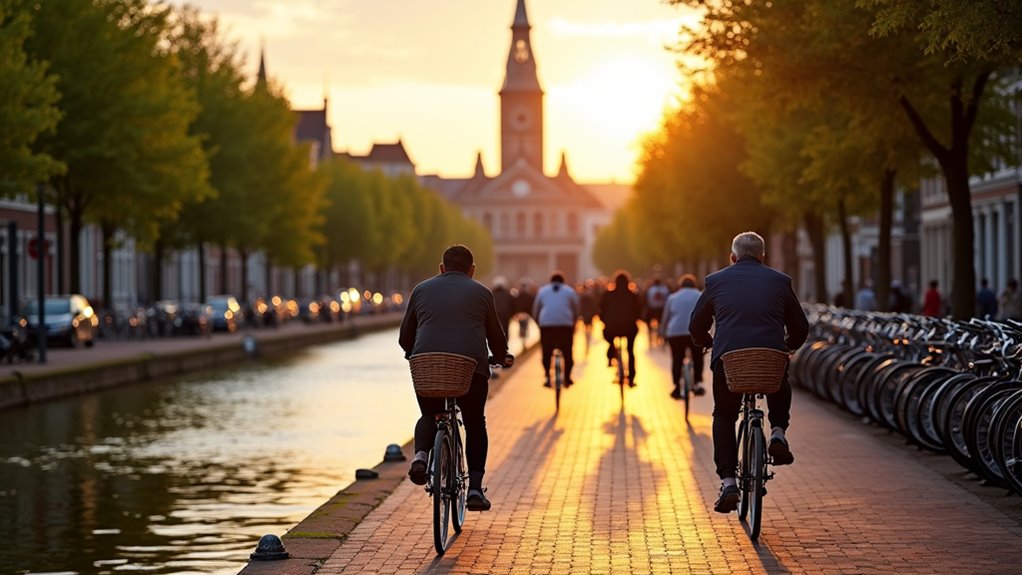
Back in the Netherlands, Utrecht showcases a different approach to cycling excellence that’s arguably even more impressive than Amsterdam’s famous canals and bike culture. You’ll discover the world’s largest bike parking garage here—a three-story underground facility housing 12,500 bicycles right beneath the central train station. It’s a proof of how seriously Utrecht takes cycling infrastructure.
What sets Utrecht apart is its seamless integration of bikes with public transport. You can cycle to the station, park securely, and hop on a train without missing a beat. The city’s flat terrain and dedicated bike lanes make navigation effortless, while traffic lights are timed specifically for cyclists’ speeds.
You’ll find yourself part of a well-oiled urban machine that prioritizes sustainable transportation above all else. When winter arrives, many cyclists transition to exploring the countryside through cozy RV camping, combining their love for outdoor adventure with comfortable accommodations during the colder months.
Although Strasbourg sits in France’s Alsace region near the German border, this European Parliament host city has quietly built one of Continental Europe’s most cyclist-friendly environments. You’ll discover a seamless network of protected bike lanes threading through medieval streets and modern districts alike.
What makes Strasbourg exceptional for cyclists:
You’ll appreciate how local culture embraces cycling as everyday transportation, not just recreation. The city’s compact size means you can reach most destinations within 20 minutes, while the flat terrain makes cycling accessible for all fitness levels. For those seeking adventure beyond city limits, Strasbourg serves as an excellent base for exploring the region’s countryside with caravan camping excursions that let you bring your bikes along for multi-day outdoor adventures.
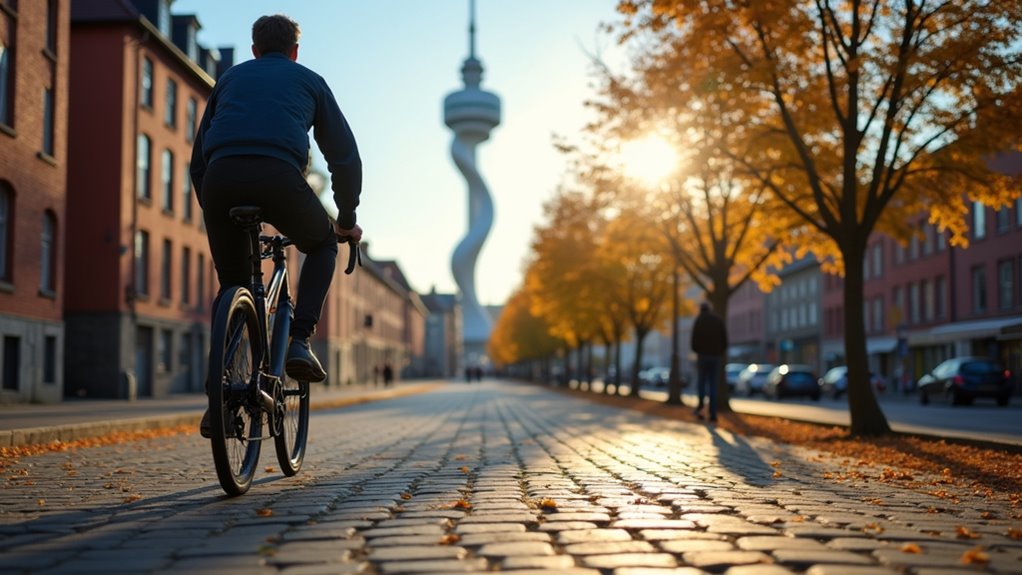
Across the Øresund Bridge from Copenhagen, Malmö has transformed itself from an industrial port city into Scandinavia’s cycling paradise. You’ll find 500 kilometers of bike paths connecting every neighborhood, making car ownership practically unnecessary. The city’s flat terrain and mild coastal climate create perfect cycling conditions year-round.
What sets Malmö apart is its innovative infrastructure. You’ll encounter bike highways with their own traffic lights, heated bike lanes that melt snow in winter, and secure parking facilities at every transit stop.
The Western Harbor district showcases sustainable urban planning where cyclists get priority over cars.
Don’t miss cycling through Folkets Park or along the waterfront promenade. Local bike-sharing programs make exploring effortless, and most residents commute exclusively by bicycle. Malmö proves that dedicated investment in cycling infrastructure transforms cities. Many cycling enthusiasts find the experience creates lasting memories and community connections similar to other meaningful group activities.
From Scandinavia’s cycling innovations, we move south to France’s wine capital, where Bordeaux has quietly become one of Europe’s most bike-friendly cities. You’ll discover 200 kilometers of dedicated bike paths weaving through UNESCO World Heritage streets and modern tramway corridors.
The city’s V³ bike-sharing system puts 1,800 bikes at your disposal across 139 stations. What makes Bordeaux special isn’t just infrastructure—it’s how cycling integrates with French lifestyle. You can bike to morning markets, cycle along the Garonne River, then park easily near wine bars.
Key cycling advantages include:
Bordeaux proves that wine culture and cycling culture complement each other perfectly, creating a uniquely French approach to urban mobility. After exploring the city by bike, give your bicycle the same care you’d give an RV with proper spring cleaning to keep it shining and ready for your next adventure.
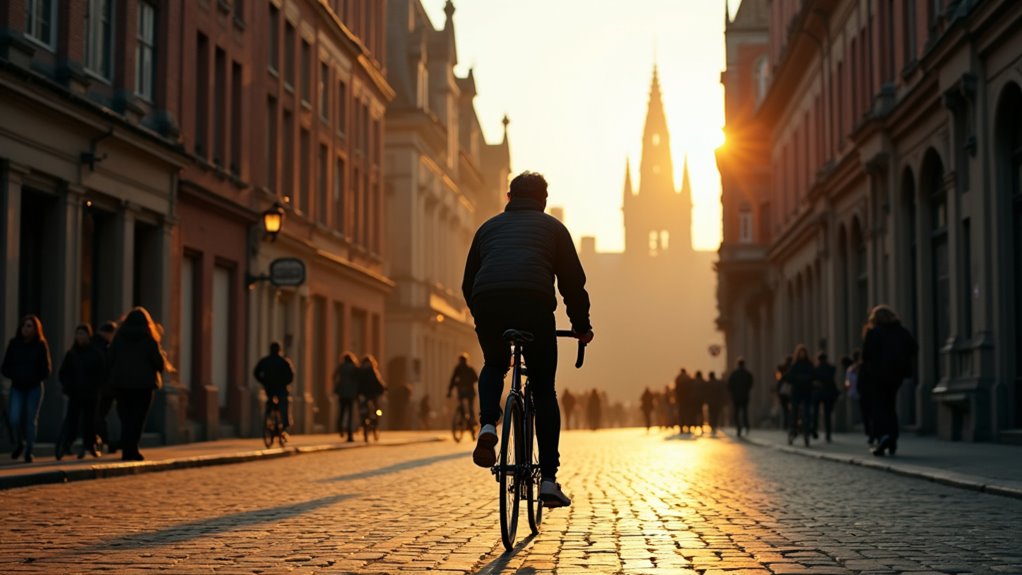
Belgium’s diamond capital showcases how medieval charm and modern cycling infrastructure can coexist beautifully. You’ll discover Antwerp’s extensive network of protected bike lanes weaving through cobblestone squares and past Gothic cathedrals.
The city’s flat terrain makes cycling effortless, while all-encompassing bike parking facilities eliminate storage worries.
Don’t miss the scenic Scheldt River route, where you’ll pedal alongside Europe’s second-largest port.
Local cyclists embrace practical fashion over lycra – you’ll fit right in wearing everyday clothes.
Antwerp’s bike-sharing system, Velo, offers convenient pickup points throughout the historic center.
Cultural tip: Belgians cycle year-round, so pack weather-appropriate gear.
The city’s compact size means you’ll reach major attractions like the Cathedral of Our Lady or bustling Grote Markt within minutes of pedaling.
For adventurous cyclists looking to explore beyond daylight hours, consider night diving excursions from nearby coastal areas to experience Belgium’s underwater world after dark.
Nestled between the Alps and the Adriatic, Slovenia’s charming capital transforms cycling into an art form with its car-free city center and pristine bike paths. You’ll discover Ljubljana’s commitment to sustainable transportation through its extensive BicikeLJ bike-sharing system, featuring over 600 bikes across 60 stations throughout the city.
The flat terrain makes cycling effortless as you explore medieval architecture, vibrant markets, and the iconic Dragon Bridge. Ljubljana’s compact size means you can reach any destination within 20 minutes by bike.
Key cycling advantages include:
You’ll join thousands of residents who’ve made cycling their primary transportation method in this environmentally conscious European gem. For those seeking adventure beyond urban cycling, Slovenia’s proximity to the Alps also offers opportunities for glacier climbing on some of the country’s most challenging mountain terrain.
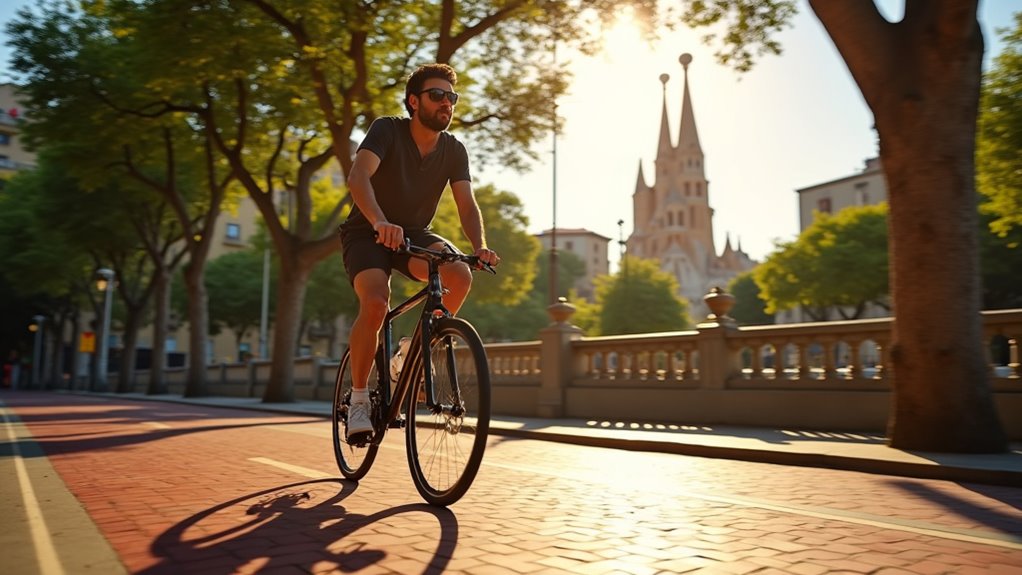
Stretching along the Mediterranean coast, Barcelona brilliantly balances urban cycling with beachside adventures through its innovative Bicing bike-share program and 200+ kilometers of dedicated bike lanes.
You’ll discover the city’s cycling infrastructure connects major attractions seamlessly—from Gaudí’s architectural masterpieces to bustling La Rambla.
The Bicing system offers convenient short-term rentals, though you’ll need local registration.
Navigate the grid-like Eixample district easily, where wide avenues feature protected bike paths.
Don’t miss the coastal route along Barceloneta Beach, where you can cycle while enjoying Mediterranean views.
Time your rides during cooler morning or evening hours, especially in summer.
Barcelona’s bike-friendly culture means drivers generally respect cyclists, but stay alert in the Gothic Quarter‘s narrow medieval streets where pedestrians and bikes share space.
When you’re ready to extend your Barcelona adventure beyond cycling, consider planning family camping activities that can complement your Mediterranean coastal experience.
While Barcelona charms with Mediterranean warmth, Vienna captivates cyclists with imperial elegance and meticulous urban planning that’s transformed Austria’s capital into one of Europe’s most bike-friendly cities.
You’ll discover over 1,600 kilometers of cycling paths weaving through historic districts and modern neighborhoods. The city’s flat terrain makes pedaling effortless, while dedicated bike lanes ensure you’re safely separated from traffic. Vienna’s bike-sharing system, Citybike Wien, offers convenient access with stations throughout the city.
What sets Vienna apart:
Vienna proves that cycling and imperial grandeur make perfect companions.
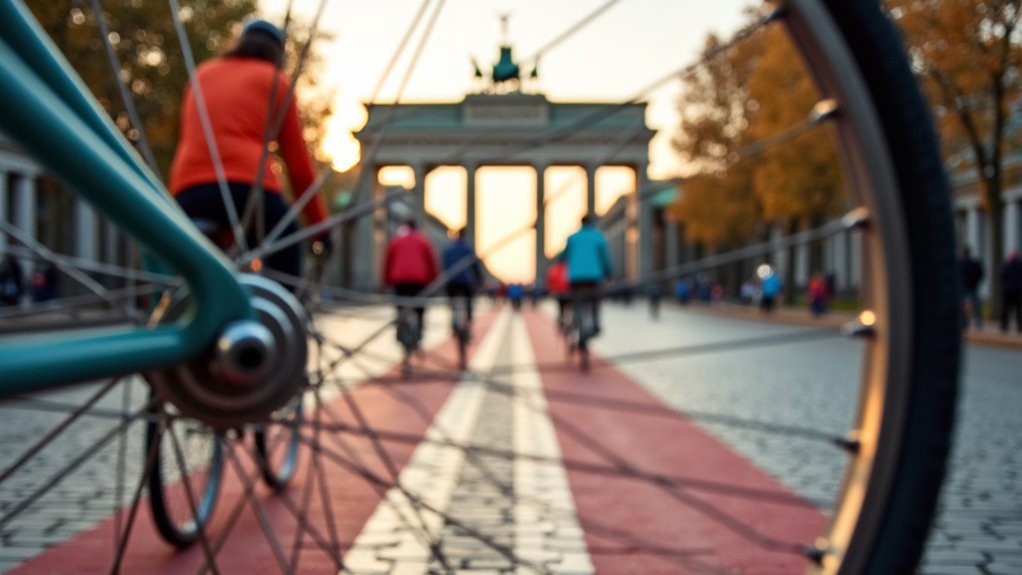
Few cities embody cycling freedom quite like Berlin, where two wheels aren’t just transportation—they’re a statement of independence that echoes through every pedal stroke across this historically divided metropolis.
You’ll discover over 620 miles of bike lanes threading through neighborhoods where East meets West. The city’s flat terrain makes cycling effortless, while dedicated bike highways connect distant districts seamlessly. Berlin’s cycling culture runs deep—locals bike year-round, rain or shine, treating their rides as daily meditation.
Don’t miss cycling along the former Berlin Wall trail or through Tiergarten’s tree-lined paths. Bike shops dot every corner, offering rentals and repairs. The city’s relaxed traffic laws favor cyclists, and you’ll find secure bike parking everywhere. Berlin proves that cycling isn’t just about getting somewhere—it’s about experiencing urban freedom.
For cyclists planning multi-day adventures beyond the city, Berlin serves as an excellent base camp where you can gather essential camping tips before heading out to explore Germany’s scenic countryside routes.
When most Americans think of bike-friendly cities, Portland instantly comes to mind—and for good reason. You’ll find over 400 miles of bike lanes, paths, and bike boulevards weaving through this Pacific Northwest gem. The city’s flat terrain and mild climate make year-round cycling comfortable, while Portland’s famous bike culture encourages commuting by two wheels.
Portland’s commitment to cycling infrastructure stands out:
Portland demonstrates exceptional dedication to cyclist safety and convenience through thoughtfully designed infrastructure that prioritizes two-wheeled transportation throughout the city.
You’ll notice Portland’s practical approach—bike racks everywhere, shower facilities at workplaces, and strong community support. The city’s laid-back vibe perfectly matches its pedal-powered lifestyle. Beyond daily commuting, Portland’s extensive trail network makes it perfect for camping trips where you can combine cycling adventures with outdoor recreational activities.
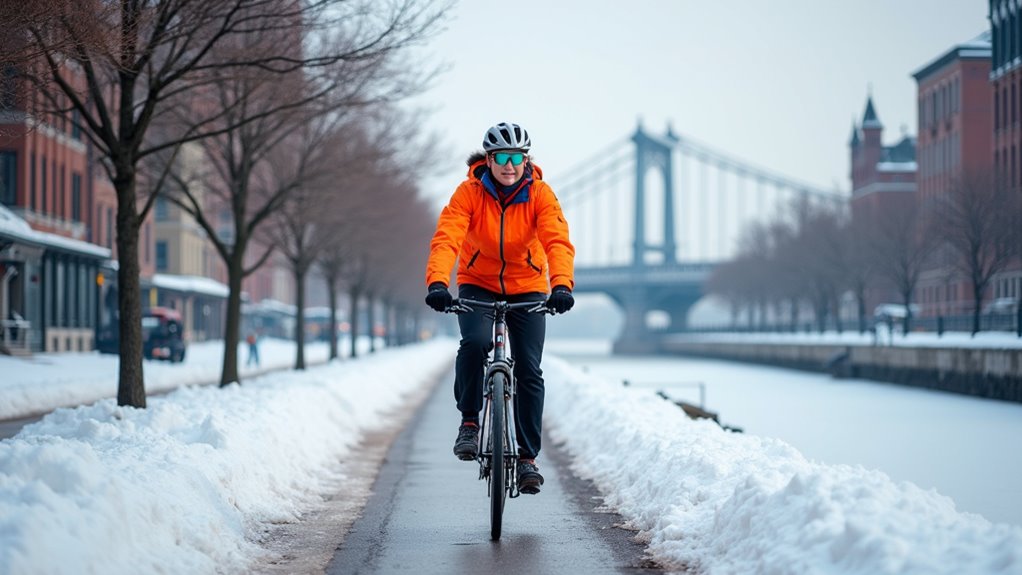
Despite facing harsh winters that would challenge any cycling city, Montreal has transformed itself into one of North America’s most bike-friendly destinations. You’ll discover over 700 kilometers of bike paths weaving through this vibrant city, including the impressive Lachine Canal route that stretches 14 kilometers along the waterfront.
What sets Montreal apart is its commitment to year-round cycling infrastructure. Many paths get cleared during winter, and you’ll find heated bike shelters downtown.
The city’s BIXI bike-sharing system operates from April to November, giving you easy access to thousands of bikes across 600+ stations.
You’ll appreciate Montreal’s cycling culture – drivers generally respect cyclists, and the city continues expanding protected bike lanes. Don’t miss exploring the Plateau neighborhood’s tree-lined streets or the scenic Old Port waterfront paths.
Moving from Montreal’s wide bike paths to Asia’s cycling scene, Tokyo presents a completely different but equally fascinating approach to urban biking. You’ll discover a cycling culture that’s deeply woven into daily life, where millions use bikes for practical transportation rather than recreation.
Tokyo’s bike infrastructure focuses on functionality over flashiness. You’ll navigate narrow streets alongside pedestrians, park at multi-story bike garages, and witness the famous “mamachari” – practical city bikes that dominate the landscape.
Here’s what makes Tokyo unique for cyclists:
You’ll find Tokyo’s approach invigoratingly practical and efficient. For those planning to explore Tokyo by bike with family, consider that expecting mothers should take extra precautions when cycling through the city’s busy streets and crowded pathways.
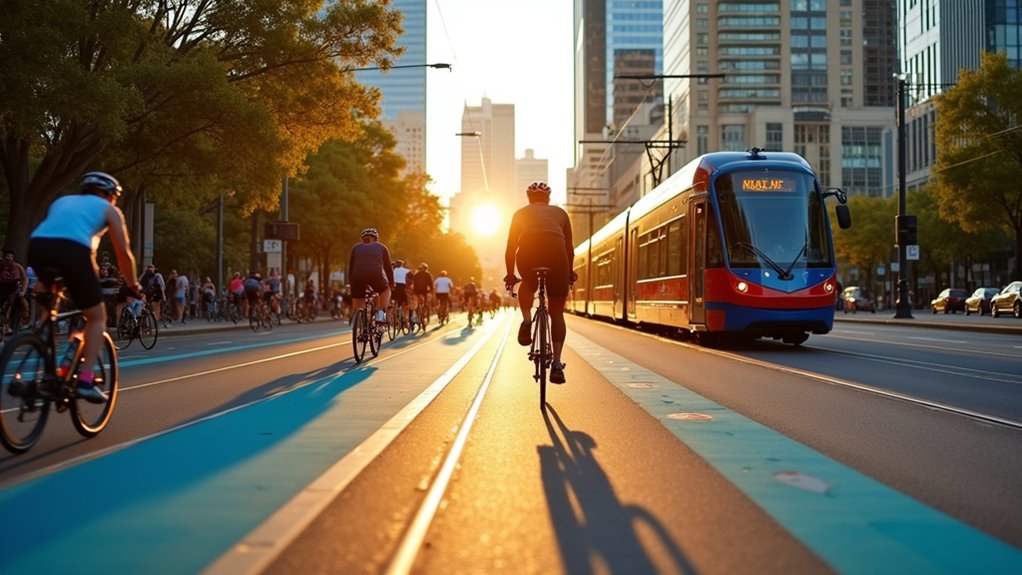
How does a city transform from car-centric sprawl to cycling paradise in just two decades? Melbourne’s done exactly that, building over 135 kilometers of protected bike lanes since 2000. You’ll find the city’s flat terrain works in your favor, making commuting effortless whether you’re heading to the CBD or exploring leafy suburbs.
Melbourne’s bike-share system puts wheels at your fingertips throughout the inner city. The real game-changer? Separated cycling infrastructure along major corridors like Swanston Street and the Capital City Trail, which loops 29 kilometers around the city.
Local cycling culture embraces both lycra-clad commuters and casual cafe-hoppers. You’ll notice bike parking everywhere – from office buildings to trendy Fitzroy coffee shops. Melbourne’s proven that strategic infrastructure investment can reshape urban mobility patterns completely. After a long day of cycling through the city, you can easily prepare quick camping recipes if you’re planning to extend your adventure with an overnight trip to nearby nature areas.
You’ve discovered cycling’s golden thread weaving through these global cities—each spoke representing a different culture’s commitment to sustainable living. Whether you’re drawn to Amsterdam’s canal-kissed paths or Tokyo’s precision-engineered routes, you’ll find that bikes aren’t just transportation; they’re keys opening healthier communities. As you consider your next adventure or advocate for change in your hometown, remember these cities planted seeds of possibility that you can cultivate anywhere.